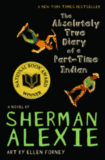 BIBLIOGRAPHY
BIBLIOGRAPHY
PLOT SUMMARY
Fourteen year-old Arnold Spirit (also known as Junior) has
always been an outsider in the Spokane Indian reservation where he lives. This coming of age stories chronicles
Arnold’s quest to better himself.
CRITICAL ANALYSIS
In The Absolutely True
Diary of a Part-Time Indian, Alexie provides a good introduction to life on
a reservation to readers unfamiliar with the lifestyle. Similar to other coming of age stories,
Arnold does not fit in in his community.
He has always been bullied and only has one true friend, Rowdy. When Arnold decides to switch schools to
better himself, he is ostracized by the reservation’s community. At his new school, Arnold is the only American
Indian. He is able, however, to carve
himself a spot within the school’s social structure.
Teenagers, especially boys, will be able to relate to the
main character, Arnold. Arnold is a
realistic character and Alexie has succeeded in creating a likeable and
authentic protagonist. Because this
story is written in the first person, readers will feel like they personally
know Arnold.
The setting of this book is split between the reservation
and the white school, Reardan. In his
descriptions of the reservation, Alexie provides enough detail that readers
will understand the poverty that the residents are experiencing. The opposite is true with Alexie’s descriptions
of Reardan. The most prevalent theme in
this story is the theme of identity, as Arnold is trying to discover who he is
as an individual, apart from his tribe.
At 229 pages, this is definitely a chapter book for older
readers. Despite the length, Forney’s
illustrations are included every few pages.
The black and white cartoons are supposed to be drawn by Arnold and
definitely supplement the story nicely.
The illustrations add information to the story, such as the description
of the differences between whites and American Indians on p. 57. The illustrations also add to the appeal of
this book to male readers. This novel
would be a good suggestion for readers who typically read graphic novels.
Cultural information is integral to this story. Alexie does not include many physical
descriptions, but he excels at describing the reservation culture. Most notably, Alexie informs readers about
the widespread alcohol abuse among American Indians. Throughout the story, Arnold mentions
alcoholism like it is not a big deal.
This, combined with the frequency it is mentioned, makes readers
understand how widespread and “normal” alcoholism is. For example, after describing his friend’s
parents, Arnold says that “My mother and father are drunks too, but they aren’t
mean like that” (p. 16). Later, Arnold
says that “I only know, like, five Indians in our whole tribe who have never
drunk alcohol” (p. 158). Alexie succeeds
at describing cultural differences between American Indians and whites, but he
also does well in explaining how the two cultures are similar. Arnold’s parents, like parents of other
ethnicities, want better for their children than they had themselves:
“But it isn’t weird
that my parents so quickly agreed with my plans. They want a better life for my sister and
me. My sister is running away to get
lost, but I am running away because I want to find something. And
my parents love me so much that they want to help me. Yeah, Dad is a drunk and Mom is an ex-drunk,
but they don’t want their kids to be drunks.”
Throughout this story, Alexie uses humor address some tough
issues. This is an entertaining read and
effectively teaches readers about cultural intricacies. Some of the topics may be mature for very
young readers, but readers in grades 8 and up will be a perfect fit for this
story.
REVIEW EXCERPT(S)
Booklist: “Younger
teens looking for the strength to lift themselves out of rough situations would
do well to start here.”
School Library
Journal: “The teen's determination to both improve himself and overcome
poverty, despite the handicaps of birth, circumstances, and race, delivers a
positive message in a low-key manner. Alexie's tale of self-discovery is a
first purchase for all libraries.”
CONNECTIONS
In the following books, Alexie presents similar themes:
Sherman Alexie. War Dances. ISBN 9780802144898
Sherman Alexie. The
Lone Ranger and Tonto Fistfight in Heaven. ISBN 9780802141675
Sherman Alexie. Face. ISBN
9781931236706

